There are four steps that I encourage students to take in order to make an outline for a sermon – select an easy passage, sketch a block diagram, shape the sermon outline and scribe the outline into a manuscript.

How Do You Make an Outline For a Sermon?
- Select an easy passage of Scripture
- Sketch a block diagram of the passage of Scripture
- Shape the sermon outline to follow the passage of Scripture
- Scribe the sermon outline into a full manuscript
I never write a sermon until I have created the sermon outline. The sermon outline is the body of the sermon.
The sermon generally has three parts – an introduction, a body and a conclusion. The introduction of the sermon introduces the sermon topic. The body of the sermon expands and explains the sermon topic. The conclusion of the sermon concludes the sermon.
How to make an outline for a sermon is about the body of the sermon. These are the FOUR STEPS that I encourage students to master so that they can make an outline of the sermon. I want to highlight that these four steps are for beginners (students).
1. Select an Easy Passage
The best place to start is to select a verse or verses of Scripture that are familiar to you and are relatively easy to preach.
I want to select two passages of Scripture in order to show you how to make an outline of a sermon.
The first passage is from 2 Timothy 3:16-17: “All Scripture is given by inspiration of God, and is profitable for doctrine, for reproof, for correction, for instruction in righteousness, that the man of God may be thoroughly equipped for every good work.”
The second passage is from Hebrews 4:12-13: “For the word of God is living and powerful, and sharper than any two-edged sword, piercing even to the division of soul and spirit, and of joints and marrow, and is a discerner of the thoughts and intents of the heart. And there is no creature hidden from his sight, but all things are naked and open to the eyes of him to whom we must give an account.”
2. Sketch a Block Diagram
A block diagram is a visual aid to help you organize the patterns of thought being discussed in the Scriptures under investigation.
Block diagramming is a skill, once mastered, which will help you create sermon outlines with ease.
A. Block Diagram 2 Timothy 3:16-17
When you block diagram (also known as a mechanical layout) 2 Timothy 3:16-17, you will find that these verses have a natural outline – God’s word is inspired, God’s word is profitable and God’s word is dependable (see image below).
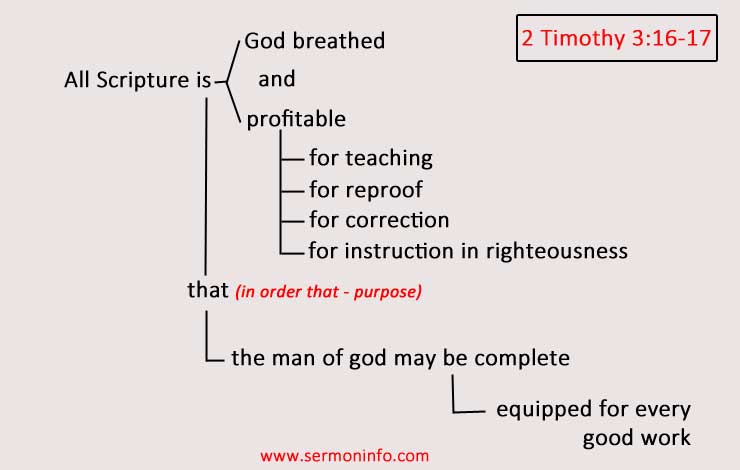
Not only does the block diagram provide a natural outline, it also provides explanatory points that will help you preach the text.
For example, God’s word is profitable because it establishes right belief and it establishes right behavior. Also God’s word is dependable because it brings people to maturity and it equips people for ministry (I will explain this in greater detail in the next step).
B. Block Diagram Hebrews 4:12-13
When you block diagram Hebrews 4:12-13, again you will find that these verses have a natural outline. The natural outline is divided into two section. They are the ministry of God’s word and the ministry of God himself (see images below).
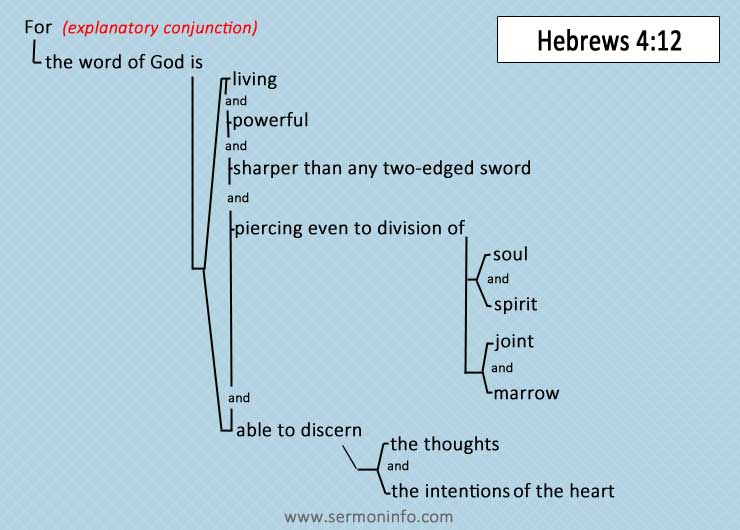
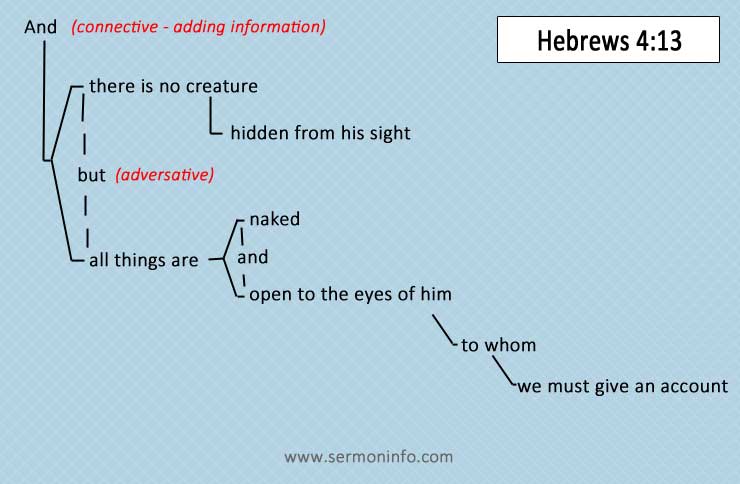
Again the block diagram shows the natural layout of the text. For example, God’s word is living, powerful, cutting, dividing and discerning. God’s presence is always before us and he tests our realness (I will explain this in greater detail in the next step).
I have written articles on the mechanical layout of the Scriptures and how to block diagram Scripture. It would be worth reading these articles.
3. Shape the Sermon Outline
Once you have block diagrammed the passage of Scripture, you will need to take that information and shape it into a preaching sermon outline.
There are basically two ways to shape the sermon outline. You could shape it in a deductive format or an inductive format.
A. A Deductive Format
The deductive format (see image below of 2 Timothy 3:16-17) states the topic at the beginning. It then expands and explains the topic with sub-points and incidental points.
The main preaching point is the topic of the sermon – Embracing the Power of God’s Word. I explained why we need to embrace the power of God’s word.
The sub-points expand and explain the main preaching point. There are three sub-points (see image below). God’s word is inspired, profitable and dependable.
The incidental points expand and explain the sub-points. I used texts outside the passage to expand and explain the first sub-points. However, I used the text itself to expand and explain the second and third sub-points.
The key word is “reason” and the key word swings all the sub-points off the main preaching point. It must be a plural noun.
For example: the first reason why we need to embrace the power of God’s word is because God’s word is inspired. The second reason why we need to embrace the power of God’s word is because it is profitable. The third reason why we need to embrace the power of God’s word is because it is dependable.
With a deductive sermon outline, you simply present the message in a logical, coherent and progressive way. The congregation will clearly see what you are sharing with them.
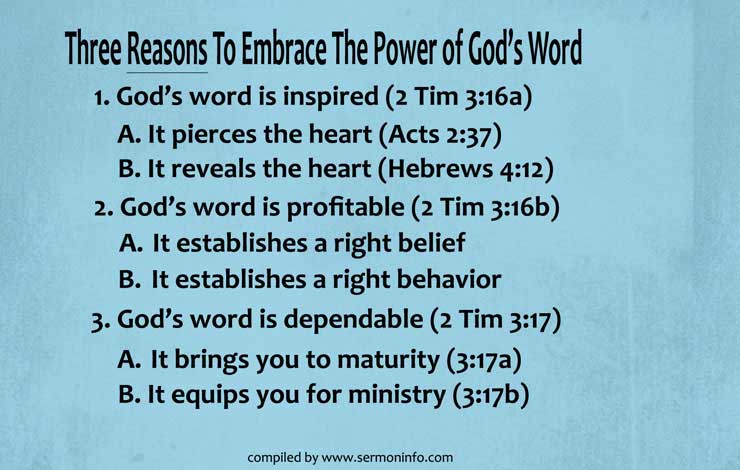
B. An Inductive Format
There are several different models for inductive sermon outlines. If you want to see the different models, click on this link and you can read the article I wrote on how to write an inductive sermon outline.
I will use Stanley’s inductive sermon structure – here is a brief overview of Stanley’s model!
ME – Here is a problem I have or have had!
The ME stage is about engaging the congregation and building common ground for the people to listen.
WE – Here is how this affects all of us!
The WE stage takes the struggles and weaknesses by boarding the tension so as to include everyone.
GOD – Here is what the Bible says about the situation!
The GOD stage is all about resolving the tension and the problem presented.
YOU – Here is what you should do!
The YOU stage is where you tell the congregation what to do.
WE – Here is what happens if we all put this into practice.
The WE stage is about vision casting. Just imagine what would happen if we all put this into practice.
The inductive model begins with several loosely associated points which are brought together or narrowed down in order to present the main preaching point (topic) with an important message and application. I have put together an attentive inductive sermon outline below (see image).
My point is to create tension with the fact that we live in a noisy world with many competing voices wanting our attention (telling us what to do and how to live!). But there is one voice we need to hear and heed. This voice is heard through God’s word. It is God’s word that shape our life not the many voices from the world. What would happened if we all heard and heeded God’s Word for life?
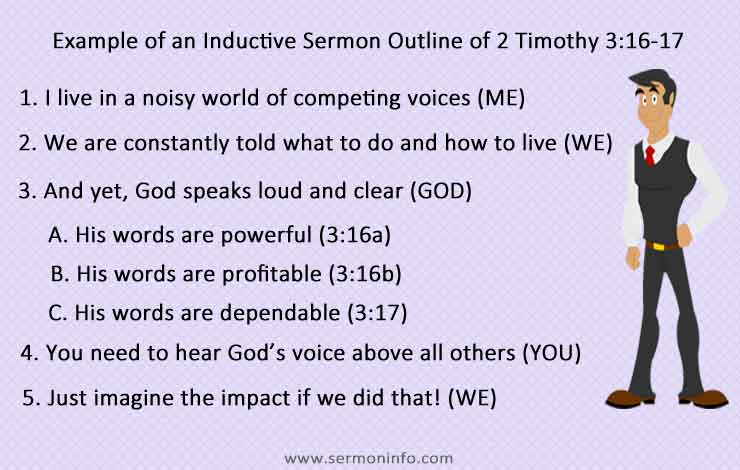
4. Scribe the Outline into a Manuscript
Once you have the sermon outline, you will need to add content to the sermon outline. Remember the sermon outline is only the skeleton (the bones). By adding content, you are added flesh to the skeleton.
Once you have adding content to the sermon outline, you will need to add several appropriate illustrations where necessary to give the message power an insight.
This will lead to writing the introduction and then the conclusion. The conclusion reinforces the main preaching point with appropriate action.
How do you make an outline for a sermon is flexible; however, once you master the skills shared above, you are on your way to creating sermons and sermon outlines with ease.